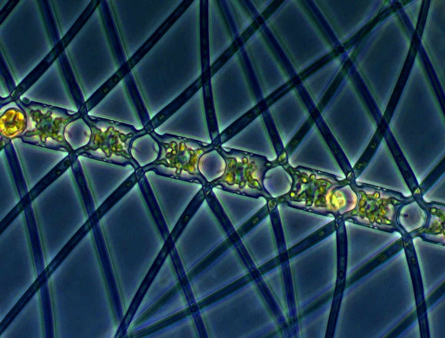Iron versus climate change
Metal deposits can promote the growth of ocean algae that gobble greenhouse gas
Share this:
- Share via email (Opens in new window) Email
- Click to share on Facebook (Opens in new window) Facebook
- Click to share on X (Opens in new window) X
- Click to share on Pinterest (Opens in new window) Pinterest
- Click to share on Reddit (Opens in new window) Reddit
- Share to Google Classroom (Opens in new window) Google Classroom
- Click to print (Opens in new window) Print
By Roberta Kwok

In 2004, a team of scientists traveled by ship to an enormous whirlpool in the ocean near Antarctica. Their goal was to find out if a risky strategy for fighting climate change might work. The plan: Dump iron in the water to trigger the growth of algae. Then let the algae soak up carbon dioxide. This gas that contributes to global warming. Finally, watch to see if the organisms drift to the seafloor.
This iron fertilization of algae appears to have been successful. That’s what an international team of researchers reports in the July 19 issue of Nature. Algae indeed removed carbon dioxide from the atmosphere, then sank deep into the ocean. Some scientists still aren’t sure if such iron fertilization is a good idea. Still, this study is one step toward showing that the tactic for fighting global warming holds promise.
Climate change is a major problem facing the planet. As cars and factories release gases such as carbon dioxide that trap heat, Earth slowly warms. Rising temperatures can melt glaciers and ice sheets. This can cause sea levels to rise. Some plants and animals may go extinct if they can’t adapt to a warmer world.
One way to solve this problem is to cut the amount of carbon dioxide released through human activities. But it would also help to suck some of the extra carbon dioxide out of the atmosphere.
Iron fertilization is one method that scientists have proposed to do so.
Fertilizers function like food supplements. They make sure an organism has enough minerals to effectively use food to fuel essential processes like growing and reproducing. Most algae are photosynthetic. That means they grow by absorbing light and carbon dioxide and using those raw materials to make sugar and oxygen.
To absorb the light, these organisms need a pigment called chlorophyll. And to make chlorophyll, they need iron. If iron is in somewhat short supply, this can reduce how well algae can harvest carbon.
If people add iron to the ocean, the thinking goes, more algae will grow. After sucking carbon dioxide out of the air, these algae may eventually sink and carry that carbon to the ocean floor. Once the carbon is at the bottom of the ocean, it could remain buried there for centuries.
Other experiments have shown that the first part of the process works — that adding iron promotes the growth of algae, which then remove some carbon from the atmosphere. But scientists have had a hard time proving that this carbon later sinks, rather than just reentering the atmosphere.
To test the second part of the process, the research team dumped iron powder into a whirlpool in the Southern Ocean. Because the whirlpool traps material instead of letting it drift to other parts of the ocean, the scientists could track this carbon.
Sure enough, a giant bloom of algae, called diatoms, grew. These tiny organisms have a shell of a hard material called silica. After a few weeks, many diatoms died.
The researchers collected water samples at various depths. They monitored the diatoms at each depth. Much of the dead diatom mass sank 1,000 meters or more. A lot of it probably reached the bottom of the ocean. The team calculated that more than half of the carbon absorbed by the diatoms also likely sank to the seafloor.
Iron fertilization is not a perfect solution. The researchers’ experiment removed only a tiny fraction of the carbon dioxide released through human activities each year. And iron fertilization might put other organisms in danger by increasing levels of algal poisons in the ocean.
Power Words
algae A large group of organisms ranging from meters-long seaweeds to single-celled microorganisms. Most algae are photosynthetic, meaning that they use light and carbon dioxide to make sugar and oxygen.
diatom A microscopic type of algae with a shell of hard material called silica.
carbon dioxide A gas made of one carbon atom and two oxygen atoms.
fertilization The addition of chemicals that encourage growth.
photosynthesis The process of converting light and carbon dioxide to sugar and oxygen.
chlorophyll A pigment that photosynthetic organisms need to absorb light.






